Bruce Varner Photography BruceVarner.com



SX-70 Camera Comparisons
--Testing Which Camera To Shoot When Exposing Polaroid Originals Film--
Take note that camera #1 and #2 measures for SX-70 speed film. Cameras #3 and #4 had been modified, and used 600 film. I believe that many of the different "looks" of he images are in part due to the different film emulsions between these two speeds.
TEST #1
Indoor still-life. Close subject.
!!Note!! Still-life scene
consisted of the three vases sitting on a white background, in a dark
room. Continuious studio corrected lighting was produced by two lamps. I
intentionally used low light to mimic many common indoor lighting
conditions. I
could not get the background to appear white in any of the Polaroid
Originals shots. Continual lightening of the exposure dial
resulted in a lighter background, but would also washout the subject
vases. Since the subject was the most important part of the
images, I did not try to make the background accurately white.
The Instax film did a halfway reasonable job of achieving a white
background, and shows the increased latitude of that film. Polaroid Originals
color film is just not good in lower
light, nor in high contrast settings. For an idea of the amount of light placed onto the
scene, look at the exposure settings used in the Instax and digital
exposures. Cameras #1 & #2 used a setting 2 stops lighter than
normal, which whould have been
the best exposure for the subject vases. Cameras #3 & #4 used a
setting 1 stop above normal.
This scene was used to show the in ability to achieve white and good
focus in
lower light.
I did later set up this same scene, only using a mid-grey backdrop. The results were much more pleasing. Why? Because the 18% grey was much closer in tone to the vases, requiring less dynamic range to reproduce the scene. Therefore the film could capture all the shades more easily.
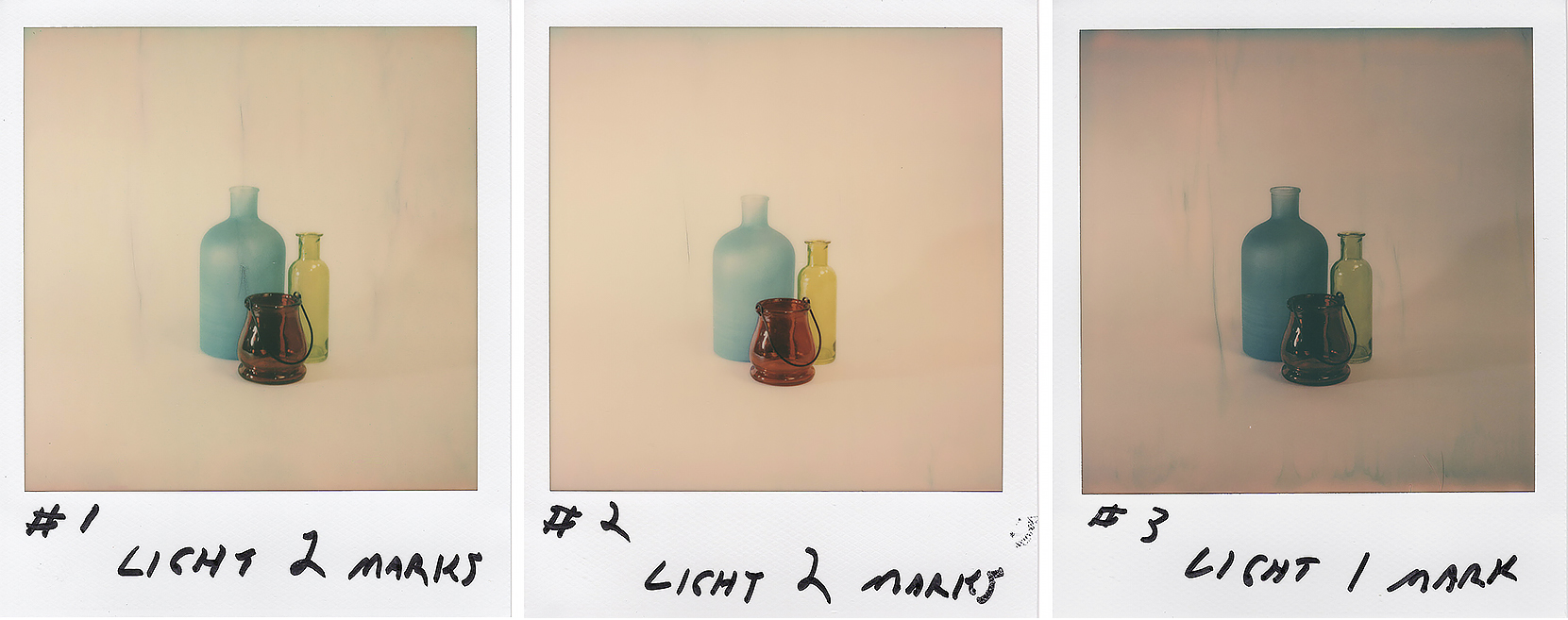
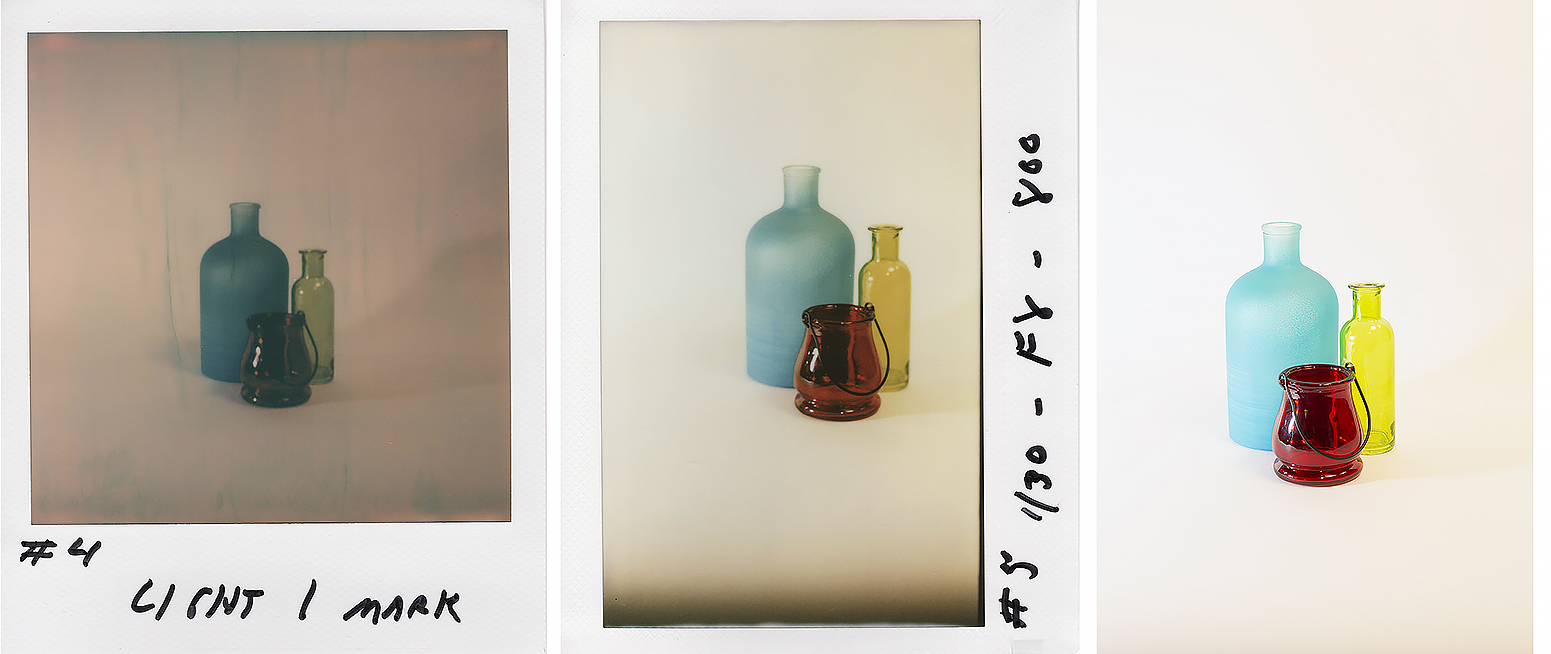
Camera #1: + 2 lighten. Focus accuracy was the furthest off with this
camera. At a measured distance of 3', sharpest focus in the focus
test was actually
at a distance
of nearly 4'. However, after several focus settings, I actually
achieved best focuse at a distance of 2' 6". See
Enlargement
Camera #2: + 2 lighten.
A measured 3' actually focused the sharpest at a distance of about 3' 6".
However, after several focus settings, I actually achieved best focuse
at a distance of 2'
8". See Enlargement
Camera #3: + 1 lighten. Close
focus was dead on with this camera.
See Enlargement
Camera #4: + 1 lighten. Close focus was
on with this camera. See Enlargement
Camera #5:
1/30 sec-f8-ISO 800. See Enlargement
Camera #6: 1/30 sec-f8-ISO 800.
The control sample. Same exposure as used with the Polaroid 110a.
See Enlargement
TEST #2
Sunny Day. Colorful subject.
A local Kansas City colorful area. Called Graffeti Alley. At
this spot the alley is about 11' wide. Exposed scene is in direct
sunlight, high over my right sholder. See how much better the film
reacts to bright exposures. I focused each camera based upon the
results of the earlier focus testing. Remember that the purpose of
these tests were to compare
clarity results.
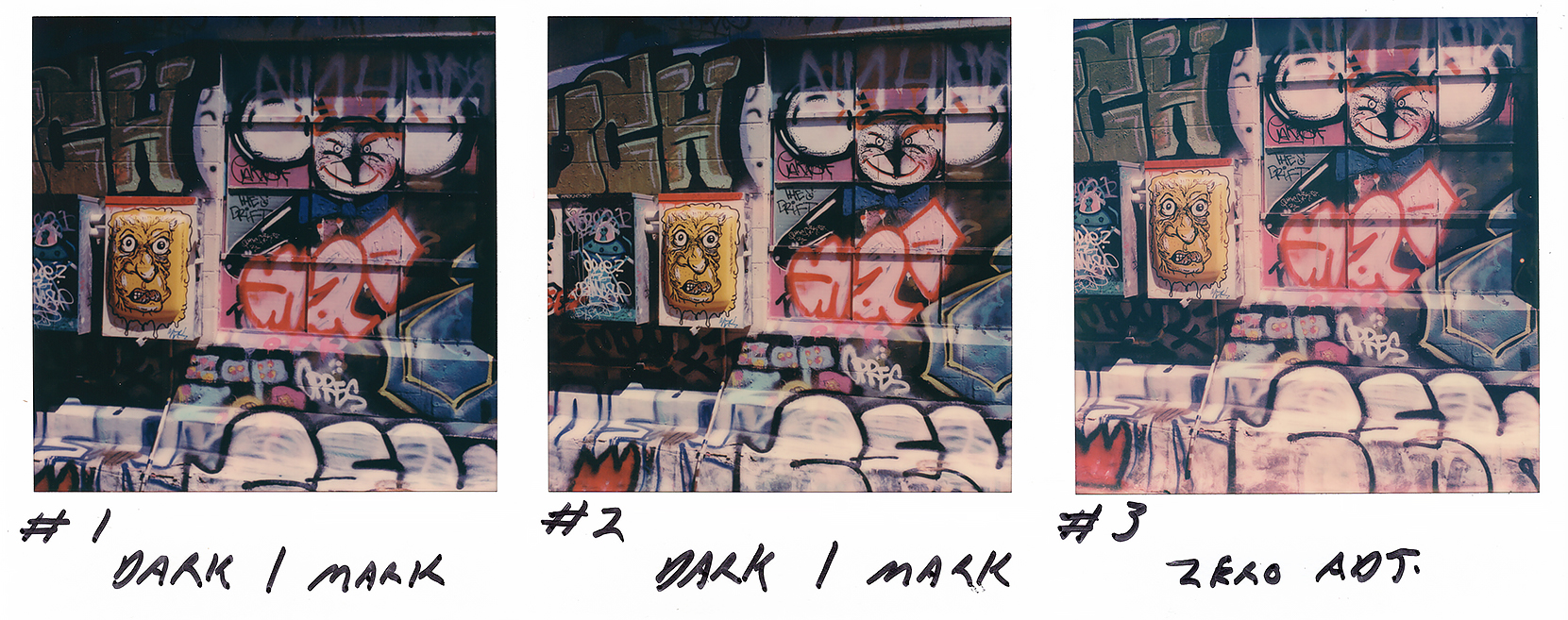
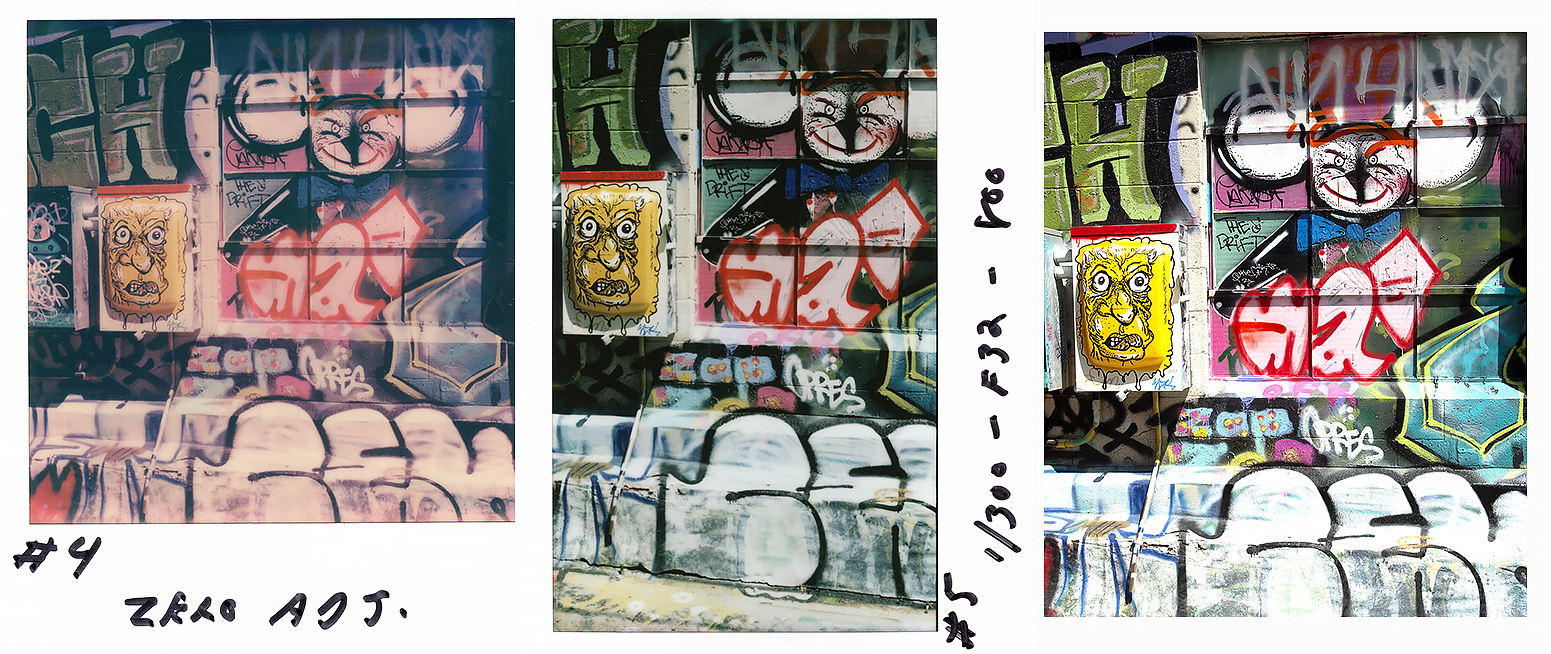
Camera #1: + 1 darken. Focused at 6'. See
Enlargement
Camera #2: + 1 darken.
Focused at 9'. See Enlargement
Camera #3:
Exposure nominal. Focused on wall.
See Enlargement
Camera #4: Exposure nominal. Focused on
wall. See Enlargement
Camera #5:
1/300 sec-f5.6-ISO 800. See Enlargement
Camera #6: 1/300 sec-f5.6-ISO 800.
The control sample. Same exposure as used with the Polaroid 110a.
See Enlargement
TEST #3
Sunny Day.
Distance & Sky.
Garage door on this elevator is
approximately 60' away. Again direct sunlight over my right
shoulder and some sky
included. I did not use tripod for this testing. Also, the
images from camera's 3 & 4 were taken only minutes after the film for
each was removed from the cooler. Hence, I believe the pinkish
tent in 3 and the under exposure of 4. I was pressed for time
during this exercise.
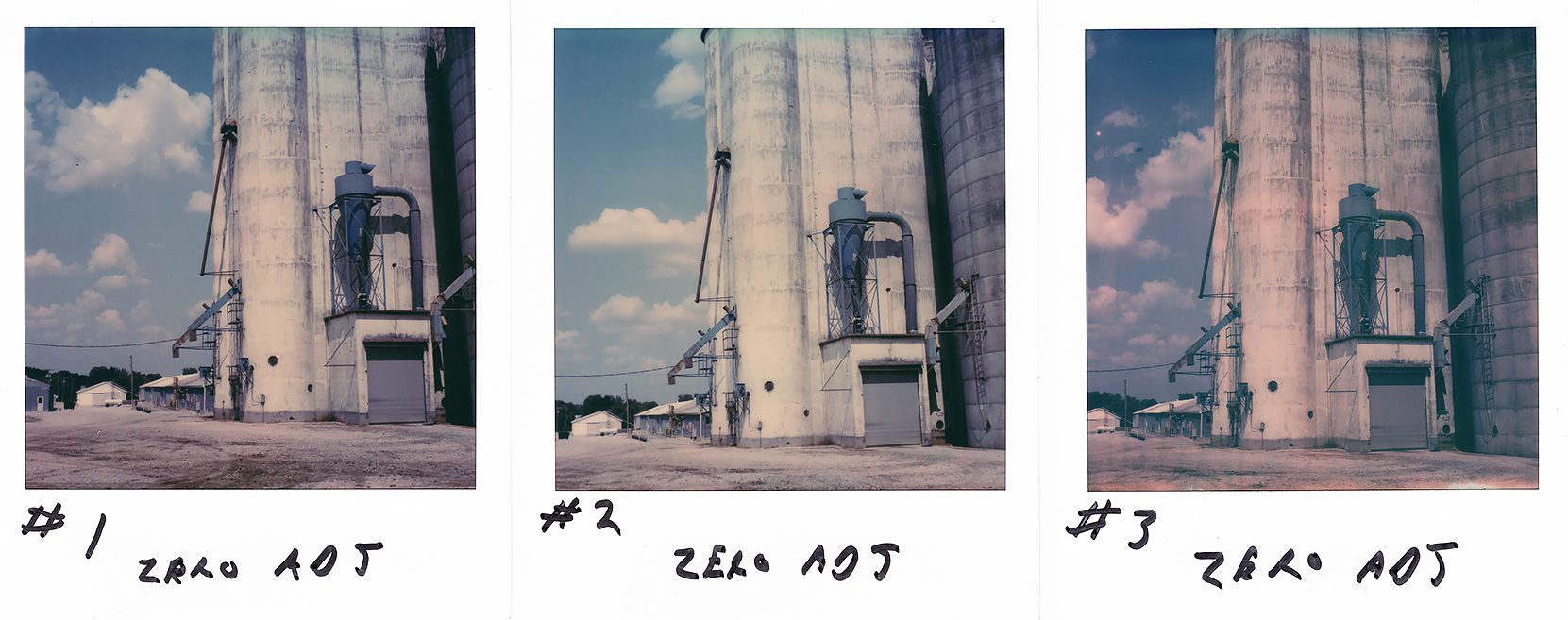
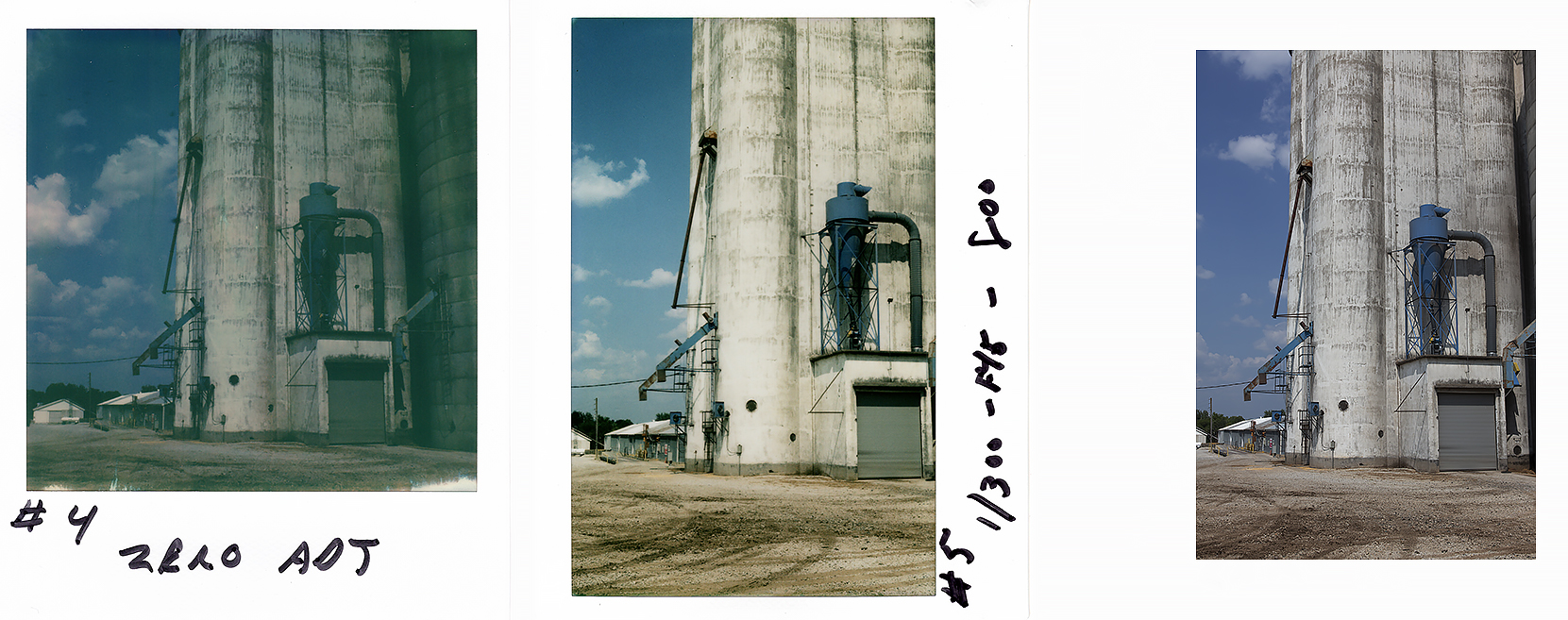
Camera #1: Exposure nominal. I focused
about 20' in front of the garage door. See
Enlargement
Camera #2: Exposure nominal.
I focused about 20' in front of the garage door. See Enlargement
Camera #3:
Exposure nominal. See Enlargement
Camera #4: Exposure nominal.
See Enlargement
Camera #5:
1/300 sec-f8-ISO 800. See Enlargement
Camera #6: 1/300 sec-f8-ISO 800.
The control sample. Same exposure as used with the Polaroid 110a.
See Enlargement
Conclusions
I was surprised at the
results for several reasons. I have always been a fan of the
SX-70, and still am, but I am now a lot more critical of the system than
before. Here are my opinions after completion of all tests, even
those not presented above:
I had hoped that there would be a clear difference in image sharpness between the untouched camera, and the "refurbished" cameras. There was not. While conducting these tests, I did the tests with some of my other SX-70 cameras. I am now convinced that while no SX-70 camera produces sharp images, some SX-70 cameras are much sharper than others. I could not find that "refurbishing" helped in making the images sharper. Look at a film pack with the dark slide removed, and the actual film is exposed in the pack. Like it would be when being exposed in the camera. Now look at that film from a low angle, so you are seeing accross the film. It does not look very flat to me! I think this is another reason the focus seems to be a changing occurance.
As a general statement, it seemed to me that the Polaroid Originals SX-70 Color film had better color rendition than the Polaroid Originals film in 600. The 600 film seemed to be more likely to be tinted in anything less than ideal lighting conditions.
If your SX-70 is a known correctly functioning camera, always first suspect the film as the cause of issues, before blaming the camera.
Update 06/11/19--- Remember that subsequent batches of Polaroid Originals film continues to get better. So as time goes on, these specific results will not be valid. The issues involved however, will remain..................
If you are going to just play with an SX-70 camera, do so with an inexpensive example. Then if you wish to go further you can. To me, just putting a couple of packs of film through the camera a year, is playing.
On the other hand if you will be using your SX-70 regularly, get it refurbished! That is unless you are not bothered that your SX-70 will stop working at any moment. If smooth operation is not important. Refurbish an SX-70 camera for these benefits, not because you believe it will produce better images! As anyone should expect, the un-refurbished camera was not fully reliable. I have had many unrefurbished SX-70 cameras and have yet to find a single one that I would consider reliable. Maybe I am just getting to that age, but my time is too valuable to spend in the field with a 40 year old camera that has not been thoroughly cleaned, lubed, & adjusted.
If you want to be able to manually adjust settings, the Mint SLR670s is the choice. It opens many possibilities. Those possibilities come with a hefty financial cost.
At this point I am unable to really see a reliability difference between the 2nd Shot and the Mint refurbished cameras. The 2nd Shot refurbished are great little cameras! I have had several over 3 or 4 years, and all have functioned well. I do have to say that the Mint camera was the only refurbish I have every had that really feels like I received a brand new camera!. Buttery smooth. No mars or marks what-so-ever. If you want to feel like you actually have a new camera, this is the one. Not trying to minimize the 2nd Shot at all. They are tremendous cameras! In reality, for most people I think the 2nd Shot is the way to go for a refurbished camera. One is paying a lot of money for the difference between 2nd Shot and Mint. But for the person who has to have only the best of the best, Mint is it. Many have probably noticed that I had no camera from Polaroid Originals in the mix. That is because I have never had an SX-70 from Polaroid Originals. Not to discount them however, do have a refurbished Spectra from Polaroid Originals. It is a very pretty camera, and has functioned perfectly. So, if it is a good representation of their services, I have no complaints.
I know that there are those out there that have or will receive a lemon from any of these companies. It happens. No matter how careful these companies are, lemons are going to slip through. Remember that they are dealing with a 40 year old piece of equipment. On cameras that old, something can always break. All come with a warranty. I think that you will find these companies are responsive. They want to stay in business. But also remember that they are small businesses. Turn-a-round is not quick.
I can envision a persons conclusions to which is the best course of action changing over time. All depending upon what's important to them at that moment.
2 of the 4 cameras had excellent focusing. The 2nd Shot Sonar model, and the Mint SLR670s. I believe it is not possible to have an SX-70 that will focus accurately on every shot. I was not sure of the reason. Is focusing with the SX-70 system just inaccurate? Can it be adjusted? Some of these questions were answered for me based upon responses I had with Matt Widmann, owner of 2nd Shot. Matt addressed several issues I had observed during the testing. Here are the highlights of his feelings about these issues:
< The numeric distance scales applied to some SX-70 lenses are aluminum "stickers" that weren't positioned 100% accurately.
<
Non-Sonar models rarely lineup (Distance Marks) properly with what is
seen in the viewfinder, the infinity mark is usually off a few gear
teeth. Because of this, it's best to judge focus by using the
split-circle assist seen in the viewfinder.
In conclusion. You must expect and accept that not evey image is going to be sharp. If money was not a limiting factor, the Mint SLR670s is a wonder. The ability to manually change settings is awesome. But if you refuse to spend nearly twice the money, shoot the camera occasionally, or in bursts, the 2nd Shot refurbished cameras will be more than fine, thank you very much. I personally will not shoot a non-refurbished version of the SX-70. The film is too expensive to waste on malfunctions. The film itself provides enough of those, you do not need additional incidents because of a dirty, 40 year of camera.*****
*****I do not have any affiliation with, received any money from, or
received a reduced cost for any of these cameras. I am a consumer,
just like you. I wanted these questions answered for my own
satisfaction and thought I would provide others with the benefit (If any)
from my observations.
Epilogue
Many will conclude that spending several hundred
dollars on an SX-70 camera and then having the cost of film is a waste of
money. They may be right. But then again, who needs a Ferrari?
I personally would rather drive a Ferrari with cheap petrol, than a Yugo
with high-octane petrol. After all, the most sensible answer would be
to just take photos with your camera phone....